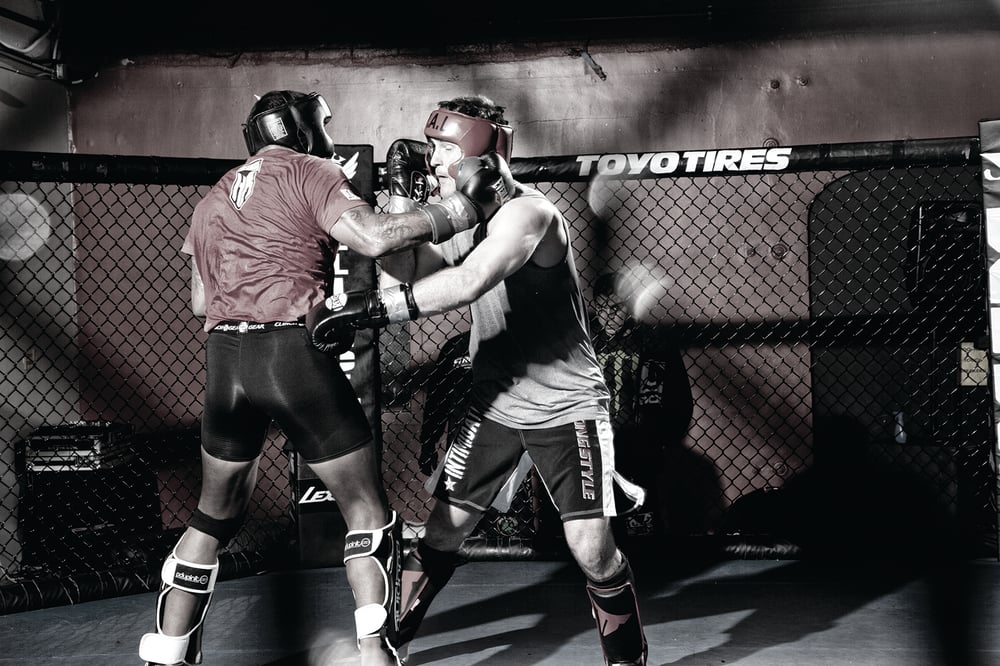
Issue 141
May 2016
Follow Brandon Gibson’s daily striking schedule to save yourself from a full-on fight at the gym
As mixed martial arts evolves, focus in training is shifting. Back in the golden days of Miletich Fighting Systems, The Lion’s Den and Chute Boxe, there was as much emphasis on toughness as technique. Fighters would hammer each other in hard sparring sessions to condition themselves for competition. Sure, it got them ready for the Octagon, but there’s no telling what damage was done to their long-term health because of all that punishment they took in practice.
Experienced competitors like Robbie Lawler have been vocal about their move away from those antiquated regimens. Their sparring is now limited, and if they do strap on their gloves for a one-on-one session it’s likely to be light – for self-preservation as much as anything. But is there still a place for a simulated scrap?
“It depends on where the fighters are at in their career and their development,” says Brandon Gibson, striking coach at Fighters Only World MMA Awards ‘Gym of the Year’ Jackson-Wink MMA. “Our highest-level fighters don’t need to focus too much on it. For a guy like Andrei Arlovski, who’s been through a lot of fights at a high level, it’s not a tool we could use to advance him that much.
“If we’re going to go in for a short duration where the fighters are really focused on implementing the game plan they want to use in their fight, it’s productive. If it’s under the coaches’ watchful eye and they’re making adjustments between rounds, sparring has a place. During fight camp it’s a waste if the guys are just getting in there to spar with each other as a workout or to make gains.
“One session a week with a good warm-up and no more than three rounds is enough. I’ve seen gyms where guys will spar 10 rounds. Whether that’s for conditioning purposes or strength-development purposes, there’s more effective areas where fighters can make those gains.”

Here are some striking solutions from Gibson for a full week’s worth of training:
Striking schedule
SPARRING
1 day a week
3 x 3-minute rounds
Remember, this is not a fight. You’re not trying to knock your training partner out. Stay relaxed and try to score points on your opponent.
Brandon says: “Sparring should be held once a week for short durations and fighters need to be very aware of the impact they take. If they take a good shot to the head they should get checked out by a physician or wait a couple of weeks before they return. Injury is my top priority for all fighters. I want to make sure they’re playing chess matches with each other when we’re in our 60s and 70s and haven’t left it all in the gym or the cage.
“We’d never have fighters spar in 4oz gloves. We have our fighters spar in 16oz gloves. They should use head gear, shin pads, knee pads and elbow pads. We can find other areas where we can push fighters 100%. I try to keep up with some of the trends and see what these other gyms are working on, but I don’t see any of the top schools sparring in small gloves or even sparring at a regular pace.”

PAD WORK
3 days a week
6 x 5-minute rounds
Get your pad man to wear shin guards so he can make you defend leg and arm strikes, as well as holding his mitts or Thai pads up to absorb yours.
Brandon says: “This is one of the best ways to simulate a fight. I’m able to make the fighter feel the pace of a fight using combos, exchanges and defensive aspects – having them think through the process and what their set-ups are going to be – rather than just blindly or aimlessly throwing combinations. For mitt work I prefer 12oz boxing gloves.”

STRIKING DRILLS
3 days a week
1-hour class
Keep things light, fast and simple. Throw two or three-shot combos at your partner, then defend or evade their strikes when they immediately return fire. Try to speed things up as the rounds progress.
Brandon says: “We do a lot of drill-based classes with the fighters. It’ll be like a two-for-two where a fighter gets to work on their combos, stance, set-ups and the defensive side. Bag work and shadow boxing can be great alternates if drilling partners aren’t available. On drilling days, we use 7oz MMA practice gloves.”
Getting started with sparring
“If you’re a young fighter – amateur or pro – I do think there’s a place for sparring, learning that toughness or how to use that defense to find that ability to come back under fire,” says Gibson. “It can be productive, but once you get to a certain level, you know you’re tough and you can take a punch, there’s no reason to do hard sparring just for sparring’s sake.”
...










